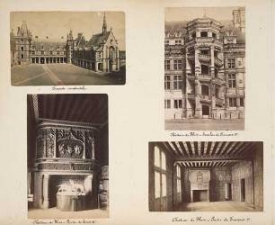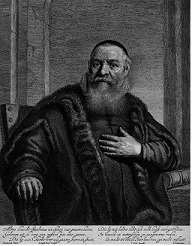Prominent in the history of the photography of works of art is the production of albums containing reproductive prints or photographs of a particular subject. In the late 1970s the department began to actively collect such objects, significantly strengthening the nineteenth-century rare holdings. These albums concern all facets of art history, with particular attention to images of Salon exhibitions, international fairs, and expositions. They range from professionally bound books intended for circulation to personal scrapbooks of trips abroad. Snapshot photography did not become widespread until the 1890s; therefore, most of the images in these scrapbooks were purchased from professionals as mementos of a trip and then arranged in an album by the traveler.
In addition to its importance for art history, the album collection is of great interest to students of the history of photography because of the wide range of processes represented. Images include photomechanical prints such as letterpress halftones, photogravures, and collotypes, as well as true photographs, including woodburytypes and platinotypes, and albumen, collodion, carbon, gelatin, and salted paper prints. (Examples of many of these processes are also found in other areas of the collection, particularly albumen, carbon, and gelatin prints.) The collection includes 660 albums to date.
Rare Collections
The library’s image collections includes rare materials, such as photographic albums, photographs of artists, and reproductive prints. Because of their age and subject matter, these holdings represent the bulk of the department's historically significant objects.

Views of the Château de Blois, France,
page from a personal travel album,
albumen prints, c. 1890s
Reproductive Prints

Mont-Saint-Michel, France, print, design by Emile Sagot, lithography by Charles Claude Bachelier
Nineteenth-century reproductive and photomechanical prints of works of art are particularly significant as they mark the beginning of the desire and ability to record artistic heritage for posterity and for a mass audience. Before the advent of photography, prints such as a lithograph of the interior of Mont-Saint-Michel made it possible for a monument in France to be seen by people all over the world.

After Albrecht Dürer, Self-Portrait at Age Twenty-Six, Museo del Prado, Madrid, design by G. Turchi, engraved by Moritz Steinla
Prints were also made of paintings and sculpture, such as an engraving after Albrecht Dürer's Self-Portrait at Age Twenty-Six in the Prado, Madrid. The collection is especially strong in prints after works by François Boucher, Pierre Paul Prud'hon, Raphael, Rembrandt van Rijn, Peter Paul Rubens, Titian, J. M. W. Turner, and Anthony van Dyck.

After Rembrandt van Rijn, Eleazar Swalmius, engraved by Jonas Suyderhoff, after 1637
A significant subset of this collection is a group of almost 500 portrait prints donated to the department of image collections in 2005 by Peter and Evelyn Kraus. Included in the gift are portraits from the Netherlands, Flanders, France, Germany, England, Italy, Switzerland, and Austria, spanning 300 years from the early 17th through the late 19 century. Although this assemblage represents the Krauses’ diverse collection interests, most of the prints are from the Low Countries. More about the Kraus Print Collection

Daniele da Volterra, c.1509-1566. Descent from the Cross. Engraved before 1867; Rome: La Regia Calcografia. Borani, Giovanni Battista, born c. 1800, delineator; Folo, Pietro, 1790-1867, engraver.
Another discrete group is the collection of chalcographic prints given to the National Gallery by the Library of Congress in 1986. The collection includes engravings and etchings pulled in the early 20th century from original 17th-19th-century copper and steel-faced plates, as well as 19th century photogravures and chromolithographs. Most are considered 'reproductive' prints after the original compositions of 16th-19th century European painters and were produced by 'chalcographic' institutions such as the Chalcographie du Louvre, Calcografia di Roma, International Chalcographical Society, and the Arundel Society. Also included is a group of bound engravings known as the Quadreria Medicea. More about the Calcographia Collection
The library is open Monday through Friday 11:00 a.m. to 4:30 p.m. We are closed Saturday, Sunday, and federal holidays.
To help us prepare materials ahead of your initial visit, we recommend you request an appointment.
Location
National Gallery of Art East Building
4th Street and Pennsylvania Avenue NW
Washington, DC
Mailing Address
Image Collections
National Gallery of Art
2000 South Club Drive
Landover, MD 20785
Contact [email protected] or call (202) 842-6026
Travels Across Russia: Oranienbaum
In Situ: Henry Moore, David Finn, and the Experience of Location
Verrocchio, Connoisseurship, and the Photographs of Clarence Kennedy
Before the Fire: Notre-Dame de Paris in Pictures
Travels Across Russia: Avant-Garde Architecture in Moscow
John Brampton Philpot and Photography in 19th-Century Florence
Beauty, Fire, & Memory: Lost Art of the Kaiser-Friedrich-Museum
Process and Participation in the Work of Christo and Jeanne-Claude
Revelations from Reproductions:
Fifteenth-century Italian Paintings in the National Gallery of Art
The Solemnity of Shadows: Juan Laurent’s Vision of Spain
Patrimony in Peril: Germany’s Survey of Mural Paintings Threatened During World War II
War Damage in Baden and Württemberg: Monuments Men Albums
Travels across Russia: Ekaterinburg
Travels Across Russia: Torzhok
United States Centennial International Exhibition
Philadelphia - 1876